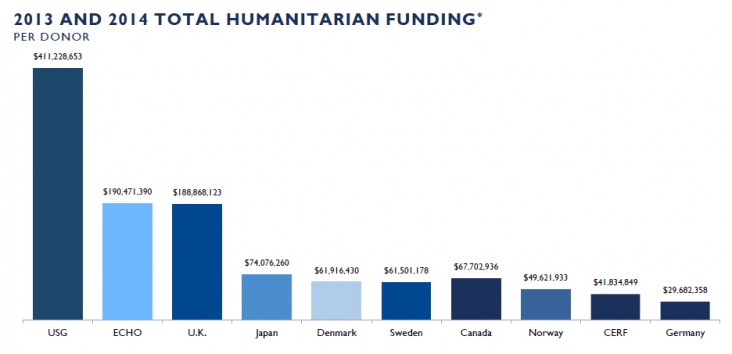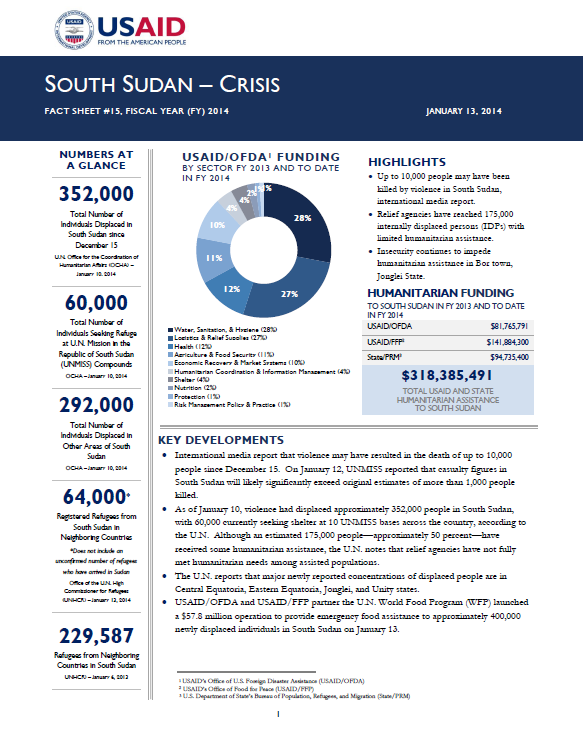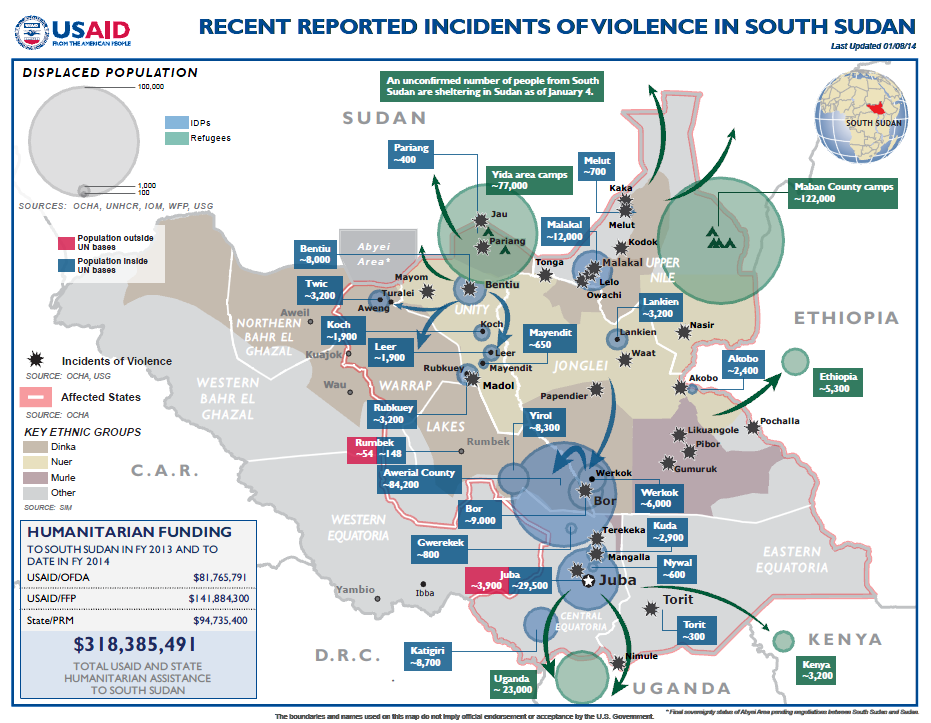- What We Do
- Agriculture and Food Security
- Democracy, Human Rights and Governance
- Economic Growth and Trade
- Education
- Environment and Global Climate Change
- Gender Equality and Women's Empowerment
- Global Health
- Humanitarian Assistance
- Transformation at USAID
- Water and Sanitation
- Working in Crises and Conflict
- U.S. Global Development Lab
Speeches Shim
January 29, 2014
Numbers At A Glance
646,400
76,500
569,900
123,400
230,200
Humanitarian Funding:
To South Sudan To Date In FY2013 and FY2014:
| USAID/OFDA | $86,383,207 |
| USAID/FFP | $141,884,300 |
| State/PRMDoD | $94,735,400 |
| TOTAL | $323,002,907 |
Highlights
Fighting since December 15 has internally displaced approximately 646,400 people.
Relief organizations have reached nearly 291,000 people with humanitarian assistance since hostilities began on December 15.
More than 2,200 children received measles vaccinations at the UNMISS base in Bor town, Jonglei State.
KEY DEVELOPMENTS
Population displacement continues to increase as insecurity persists across South Sudan, with violence displacing approximately 770,000 people—both internally and as refugees to neighboring countries—since December 15, according to the U.N. The majority of internally displaced persons (IDPs) are located in rural areas outside of UNMISS bases, with approximately 76,500 IDPs sheltering at UNMISS sites across the country.
Unpredictable security conditions continue to impede humanitarian access to conflict-affected areas, resulting in insufficient humanitarian staffing, the closure of health care facilities, and the theft of humanitarian assets. However, relief agencies continue to respond to humanitarian needs of vulnerable populations where access and security allow. USAID/OFDA partner the U.N. Humanitarian Air Service (UNHAS) has resumed flights to previously unreachable areas, such as Bentiu town, Unity State, and Bor town, Jonglei State.
During the week of January 27, Under-Secretary-General and Emergency Relief Coordinator (ERC) Valerie Amos is visiting South Sudan to attend high-level meetings to discuss expanding aid operations and improving access to communities in need. The ERC’s visit underscores ongoing international efforts to ensure the protection of civilians and aid workers, as well as advocacy for immediate and unconditional humanitarian access to all areas of South Sudan.
SITUATION, DISPLACEMENT, AND HUMANITARIAN NEEDS UPDATE
While the security situation has stabilized in some conflict-affected areas following the January 23 cessation of hostilities agreement, sporadic clashes continue in rural areas of Jonglei, Lakes, Unity, and Upper Nile states.
Conflict-induced displacement is generating increased protection concerns, including targeting of civilians, physical and sexual violence, targeted destruction of property, separation of families, and psychosocial trauma, according to the U.N. Additional Protection Cluster—the coordinating body for humanitarian protection activities, comprising U.N. agencies, non-governmental organizations (NGOs), and other stakeholders—staff are needed to enhance mainstreaming of protection activities in humanitarian response programs.
USAID/OFDA partner Mercy Corps recently conducted a rapid needs assessment of markets in Abyei Area and Twic County, Warrap State, to assess the humanitarian impact of hostilities in neighboring areas. The assessment found that the spillover effects of road insecurity and IDP influxes are affecting commodity supply chains and straining livelihoods, trade, and household finances. As transporters are reluctant to travel along insecure roads, supplies of food and other commodities are increasingly scarce, prompting increased competition among host and IDP communities for limited resources. The prices of key commodities—including cooking oil, sorghum, sugar, and wheat flour—have increased by approximately 25 percent.
Relief agencies remain concerned regarding potential disease outbreaks among vulnerable communities due to increased population displacement, limited access to safe drinking water, inadequate sanitation facilities, malnutrition, and limited access to health care services, according to the U.N. World Health Organization (WHO). Insecurity has resulted in the closure of many health care facilities, as well as the displacement of essential health care personnel and subsequent interruption of health care services.
South Sudan Crisis Fact Sheet #22 January 29, 2014 ![]() (pdf - 379k)
(pdf - 379k)
South Sudan Crisis Map January 29, 2014 ![]() (pdf - 435k)
(pdf - 435k)
HUMANITARIAN RESPONSE ACTIVITIES
Humanitarian organizations have reached nearly 291,000 people with humanitarian assistance since hostilities erupted on December 15; however, the U.N. notes that relief agencies have not fully met needs among assisted populations due to a lack of sustained, predictable access.
As population displacement continues to increase, relief agencies are conducting needs assessments in areas with significant displaced populations. Relief organizations recently conducted interagency rapid needs assessments in Dorein, Old Fangkak, Pibor, and Phom towns in Jonglei, and Wau Shiluk town, Upper Nile. Humanitarian agencies will plan and implement response activities to address assessed needs in these areas as security and access permit.
Despite insecurity and access constraints, relief organizations have reached approximately 187,100 conflict-affected people with food assistance since December 22, including 62,400 people in Lakes; 32,600 in Juba town, Central Equatoria State; 32,200 in Upper Nile; 27,300 in Jonglei; 23,200 in Unity; and 6,700 in Warrap; and additional populations in Eastern Equatoria, Western Bahr el Ghazal, and Western Equatoria states, according to the U.N.
Humanitarian organizations are addressing potential disease outbreaks through early warning systems and vaccination activities where access allows. In response to growing health concerns, the Government of the Republic of South Sudan (RSS) Ministry of Health, WHO, and other health partners have established early warning surveillance systems at IDP sites in Central Equatoria, Jonglei, Lakes, and Warrap.
To prevent health risks related to potential cases of cholera, the RSS and WHO are proposing to implement an oral cholera vaccination campaign in IDP and host communities, with initial activities prioritized in Juba and Awerial County, Lakes. Vaccination activities in Bentiu, Bor, and Malakal town, Upper Nile, would require cold chain capacity, which is currently lacking due to insecurity and fuel shortages. Ongoing, large-scale measles and polio vaccination campaigns have reached more than 7,300 children in Juba; approximately 11,300 children in Nimule town, Eastern Equatoria; and more than 4,000 children in Lankien town, Jonglei, to date.
Since hostilities began on December 15, International Organization for Migration (IOM) and partners have distributed relief items—including blankets, buckets, cotton fabric, kitchen utensils, mosquito nets, sleeping mats, soap, and water containers—to nearly 164,100 people, IOM reports. The Logistics Cluster has transported nearly 217 metric tons (MT) of relief items—including food, health, shelter, and water, sanitation, and hygiene (WASH) supplies—via road and air between January 24 and 27 to facilitate humanitarian response activities in conflict-affected areas across the country.
Since December 15, USAID/OFDA has supported nine projects—valuing nearly $2.5 million—through the IOM-managed Rapid Response Fund (RRF) in response to increased humanitarian needs across South Sudan, including in the UNMISS bases in Bentiu, Juba, and Malakal, as well as in Awerial.
With nearly $3 million in FY 2014 funding, USAID/OFDA partner Mentor is implementing comprehensive vector-borne disease control programs in Abyei Area, Lakes, Upper Nile, and Warrap. The programs aim to control and reduce the burden and impact of malaria and other vector-borne diseases among vulnerable IDP and host community populations affected by conflict, displacement, and flooding.
Central Equatoria
Despite significant improvements in WASH conditions among displaced populations at the UNMISS Tong Ping and U.N. House 3 bases in Juba, additional interventions are required due to overcrowding. The WASH Cluster reports an urgent need for additional latrines and bathing shelters, as well as improved drainage systems, at Tong Ping. While relief agencies are evaluating additional civilian protection sites in U.N. House 3 to alleviate crowded living conditions, humanitarian actors—including USAID/OFDA partners—are providing WASH support and distributing WASH supplies to the estimated 38,600 IDPs sheltering at both UNMISS bases.
Due to requests from UNMISS and the humanitarian community as the IDP population in Juba continues to increase, USAID/OFDA partner IOM is providing transportation support to decongest the two Juba UNMISS bases. With USAID/OFDA support, IOM continues to transport new IDP arrivals from the UNMISS Tong Ping base—currently hosting more than 22,900 IDPs—to UNMISS U.N. House 3—currently hosting more than 15,700 IDPs. Between December 31 and January 25, IOM had provided transportation support to more than 1,500 IDPs via 11 convoys. IOM is collaborating with UNMISS and the broader humanitarian community in Juba to ensure movement support is provided in coordination with all relevant stakeholders.
The Logistics Cluster has established an air transit facility including two mobile storage units (MSUs) near the UNMISS Tong Ping base to facilitate the storage, packaging, handling, and air transport of humanitarian cargo. In addition, the Logistics Cluster has constructed two MSUs at the U.N. House 3 UNMISS site to facilitate humanitarian assistance activities.
Jonglei
Although the security situation in Bor is relatively calm and civilians are reportedly returning to the town, clashes continue north of Bor. Violence has displaced approximately 133,900 people in Jonglei since December 15.
Relief agencies remain concerned regarding a potential measles outbreak in the Bor UNMISS compound, where suspected measles cases resulted in the death of at least 30 children since January 15, according to the U.N. Children’s Fund (UNICEF). In response, humanitarian organizations administered measles vaccinations to more than 2,200 children at the UNMISS base in Bor, from January 25–27. In addition, one relief agency resumed primary health care services at the Bor UNMISS base on January 25.
Humanitarian organizations conducted a rapid needs assessment in Pibor County, Jonglei, on January 27, finding an increasing number of people returning to their homes following violence earlier in 2013. Clusters are currently planning a response for assessed needs in Pibor town, including livelihoods support.
Lakes
Recent insecurity in Awerial has limited humanitarian assistance for the estimated 84,000 IDPs sheltering in and around Awerial’s Mingkaman town, as many relief agencies evacuated the area due to the insecurity during the week of January 20. However, some essential services—including safe drinking water and health care assistance—had resumed as of January 27, the U.N. reports.
Prior to the evacuation of aid personnel on January 22, the international NGO Norwegian People’s Aid conducted rapid needs assessments in Awerial. The assessments revealed that access to safe drinking water in Mingkaman remains limited due to damage to and overuse of boreholes in the area, while open defecation practices have contributed to increased public health risks. Relief organizations are planning to establish 1,000 new latrines that will support more than 50,000 people in Awerial, as security conditions allow.
Due to increased accessibility in Awerial and urgent humanitarian needs, Catholic Relief Services (CRS) is expanding WASH operations to reach more than 84,000 conflict-affected people in Awerial. With USAID/OFDA support through the IOM-managed RRF, CRS plans to address ongoing sanitation-related public health risks through the distribution of WASH items, hygiene promotion activities, and post-distribution monitoring.
Unity
Despite hostilities in southern Unity, relatively stable security conditions have facilitated humanitarian access to conflict-affected populations in Bentiu town. IOM is operating semi-static health care clinics and providing consultations in Bentiu, assisting nearly 120 patients experiencing diarrhea, malaria, and other illnesses between January 23 and 25.
IOM continues to register IDPs for assistance at the Bentiu UNMISS base and additional IDP sites in the town, with nearly 6,200 people registered in and around Bentiu town as of January 27, according to the U.N. Relief agencies have distributed household relief items to more than 3,200 conflict-affected people in Bentiu.
Upper Nile
Persistent insecurity continues to result in fluid population movements in Upper Nile, where nearly 150,000 people have been displaced as of January 27. In northern Upper Nile, approximately 35,000–45,000 people are reportedly moving from Paloich town, Melut County, to Daytoma village, located approximately 4 km from the Melut UNMISS base.
As of January 27, relief agencies had registered nearly 26,900 individuals for assistance at the Malakal UNMISS base. Humanitarian actors are monitoring living conditions amid influxes of new IDP arrivals, noting that the IDP area at the UNMISS base is the most overcrowded civilian protection site in South Sudan. Humanitarian agencies have begun pre-positioning relief supplies for 4,000 households in Malakal, with a humanitarian team on the ground to begin distributions.
Although unpredictable security conditions in Malakal town have hampered relief efforts, IOM re-opened a clinic at the UNMISS compound on January 26 and plans to construct tents to provide additional shelter for IDPs seeking medical assistance.
Through USAID/OFDA-funded RRF support, Danish Refugee Council staff traveled to Malakal on January 27 to commence urgent humanitarian interventions in the UNMISS base, including camp coordination and management activities, protection services, emergency shelter construction, and distribution of emergency relief commodities.
OTHER HUMANITARIAN ASSISTANCE
Since launching the South Sudan Crisis Response Plan on December 31, relief organizations have secured approximately $109 million of the $209 million in requested funding to meet immediate needs in South Sudan from January to March. However, the U.N. notes that the response plan prepared for an emergency scenario in which humanitarian organizations would assist up to 400,000 IDPs, a planning figure for displacement that has already been surpassed, with approximately 646,400 people internally displaced since December 15. Relief agencies are reviewing a revised response plan for meeting urgent humanitarian needs through June, and the U.N. plans to release the revised plan in the coming weeks.

2013 TOTAL HUMANITARIAN FUNDING*
*Funding figures are as of January 29, 2014. All international figures are according to OCHA’s Financial Tracking Service (FTS) and based on international commitments during the 2013 and 2014 calendar years. USG figures are according to the USG and reflect the most recent USG commitments based on the 2013 fiscal year, which began on October 1, 2012, and ended September 30, 2013, as well as the 2014 fiscal year, which began on October 1, 2013.



Comment
Make a general inquiry or suggest an improvement.